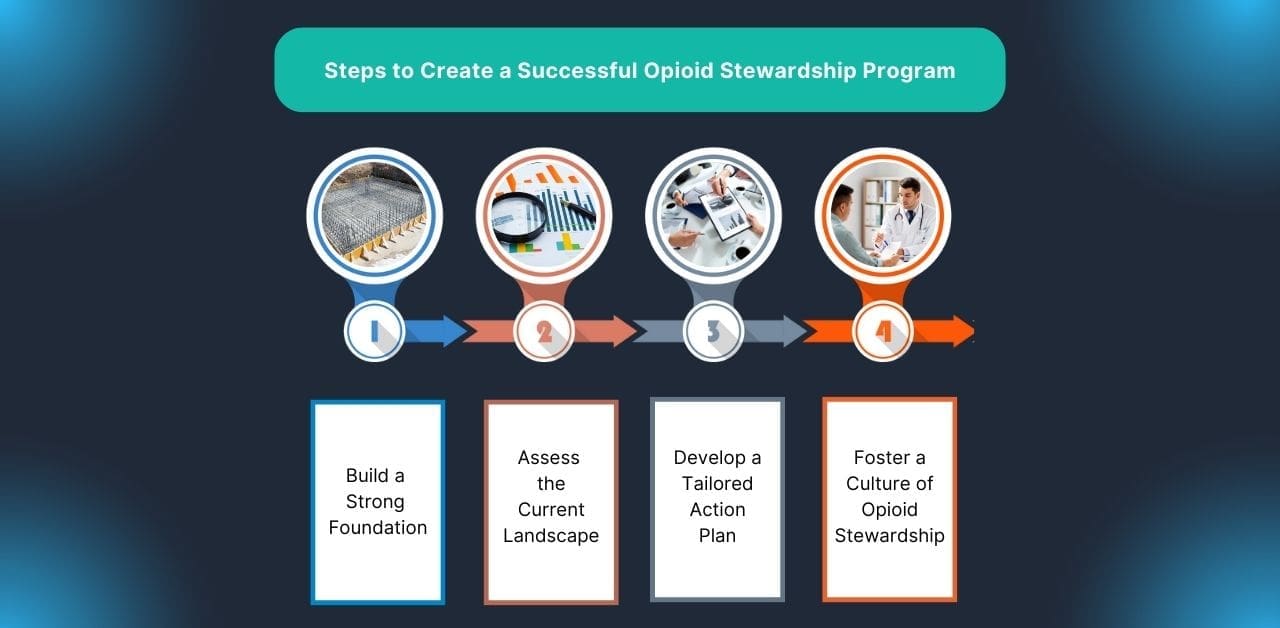According to the Health Resources and Services Administration, about 130 lives per day are lost to opioid-related drug overdoses in the United States. This staggering statistic is a stark reminder of the impact the opioid crisis can have on pharmacies. But there’s hope. Pharmacies that follow an effective set of opioid stewardship guidelines can be powerful agents of change by implementing impactful pharmacy initiatives.
Opioid Stewardship empowers pharmacies to combat the opioid crisis and become beacons of safety and support, guiding patients towards responsible pain management and minimizing the risks associated with opioid misuse.
The rest of this blog will outline key opioid stewardship guidelines for building an effective program, along with actionable steps and best practices for implementing new pharmacy initiatives.
Opioid Stewardship Guidelines For Successful Program Implementation
While there are various approaches to developing a successful program, adhering to key opioid stewardship guidelines is essential. The following steps are designed to help guide pharmacists and staff towards creating an effective and compliant opioid stewardship program.

Step 1: Building a Strong Foundation
The most crucial aspect of any project is building a strong foundation. For pharmacies, this involves establishing rapport with stakeholders, empowering pharmacists to take charge, and collaboratively defining the short- and long-term goals of the opioid stewardship program:
- Establish Rapport: Work to first gather trust and support from pharmacy stakeholders. This will make it easier to obtain resources and launch a plan-of action down the road.
- Engage Stakeholders: Secure buy-in from pharmacists and technicians. Their support and expertise is crucial for allocating necessary resources and ensuring new pharmacy initiatives are successful.
- Define Goals: What specific changes do you aim to achieve through your opioid stewardship program? This doesn’t need to be extremely detailed, think of it in a broader-sense before going into great depth. Examples include:
- Reduce controlled substance inventory discrepancies
- Minimize opioid misuse within the community
- Provide more resources to customers struggling with opioid abuse.
Step 2: Assessing the Current Landscape
With everyone on board, stakeholders equipped for success, and defined goals, it is time for pharmacies to assess their current standing. When working through this process, it is helpful to think about these three factors:
- Existing Practices: Take notice of current opioid dispensing procedures, patient counseling protocols, and safety measures. Identify areas where improvements or enhancements can be made.
- Data and Resources: Examine prescription data to understand opioid dispensing patterns, patient demographics, and potential risk factors within the community. Assess available resources, including staffing, technology, and educational materials.
- Stakeholder Input: Gather perspectives from prescribers, patients, and community partners. Understanding their concerns and insights will help shape a well-rounded set of opioid stewardship program.
Step 3: Developing a Tailored Action Plan
Now that the foundation is established and the current standing is assessed, the next step is to develop a plan of action that will achieve those goals. This is the most time-consuming part of the implementation process since there is no “one-size-fits-all” solution. Based on the goals defined when creating the program’s foundation, come up with a list of actions that will achieve them. Possible actions to consider include:
- Implementing Evidence-Based Guidelines: A good place to start is by adopting recognized opioid stewardship guidelines for safe and responsible prescribing and dispensing, such as those from the CDC, professional organizations, and state regulations.
- Enhancing Patient Counseling: Make it a standard practice to provide in-depth counseling to every patient receiving opioid medications. Cover crucial topics such as:
- Medication safety and potential side effects.
- Safe storage and disposal practices.
- Signs and symptoms of opioid overdose.
- Strengthening Prescription Monitoring: Utilize Prescription Drug Monitoring Programs (PDMPs) to track patient prescription histories and identify potential patterns of misuse or doctor shopping.
- Increasing Naloxone Accessibility: Stock and dispense naloxone, an opioid overdose reversal medication, to at-risk patients and their families. Educate them on how to recognize an overdose and administer naloxone correctly.
- Offering Disposal Solutions: Provide patients with safe and convenient methods for disposing of unused medications, such as drug take-back programs or disposal kiosks.
Step 4: Implementing Pharmacy Initiatives that Foster a Culture of Opioid Stewardship
After implementing the plans, it’s important to ensure new pharmacy initiatives continue to prioritize opioid stewardship. Maintaining a consistent culture of opioid stewardship allows pharmacies to adapt to changes and maintain safe practices. Consider these tips when implementing new pharmacy initiatives into your opioid stewardship program.
- Ongoing Training: Keep your team up-to-date with the latest knowledge on opioid safety, responsible dispensing practices, and patient counseling techniques through regular training sessions and continuing education opportunities.
- Open Communication: Encourage open dialogue among staff, prescribers, and patients. Create a space where questions, concerns, and feedback are welcomed and addressed proactively.
- Community Outreach: Partner with local organizations, schools, and community events to raise awareness about the opioid crisis and the role pharmacies play in promoting safe practices.
Opioid Stewardship Best Practices
As mentioned previously, there is not a one-size-fits-all solution for every pharmacy. However, successful opioid stewardship programs often share commonalities. Here are a few best practices:
- Utilize Technology: Embrace technology to enhance efficiency, streamline workflows, analyze data, and provide patients with accessible digital resources.
- Prioritize Patient-Centered Care: Treat every patient with empathy, respect, and individualized attention. Tailoring your approach to their specific needs fosters trust and encourages open communication.
- Embrace Continuous Improvement: Regularly evaluate your program’s effectiveness, gather feedback from stakeholders, and adapt your strategies as needed. Opioid stewardship requires an ongoing commitment to improvement.
Following a detailed set of opioid stewardship guidelines requires dedication and effort, but it’s a vital step pharmacies can take to make a real difference in their communities. By working through these four steps and implementing best practices into daily workflows, pharmacies can successfully establish pharmacy initiatives that help establish an effective opioid stewardship program.
Interested in learning more? Click these links to access more information on opioid stewardship guidelines and best practices.
